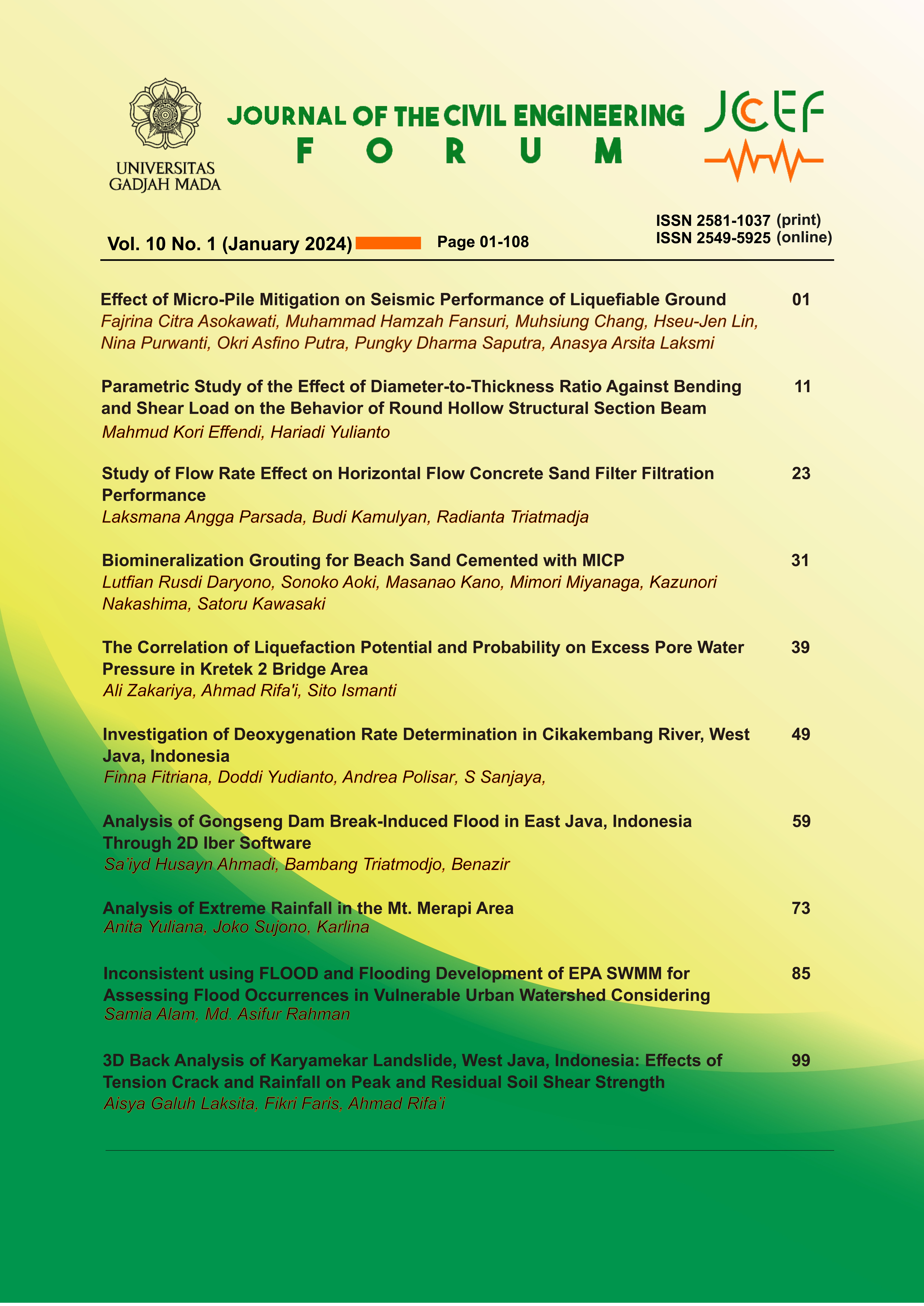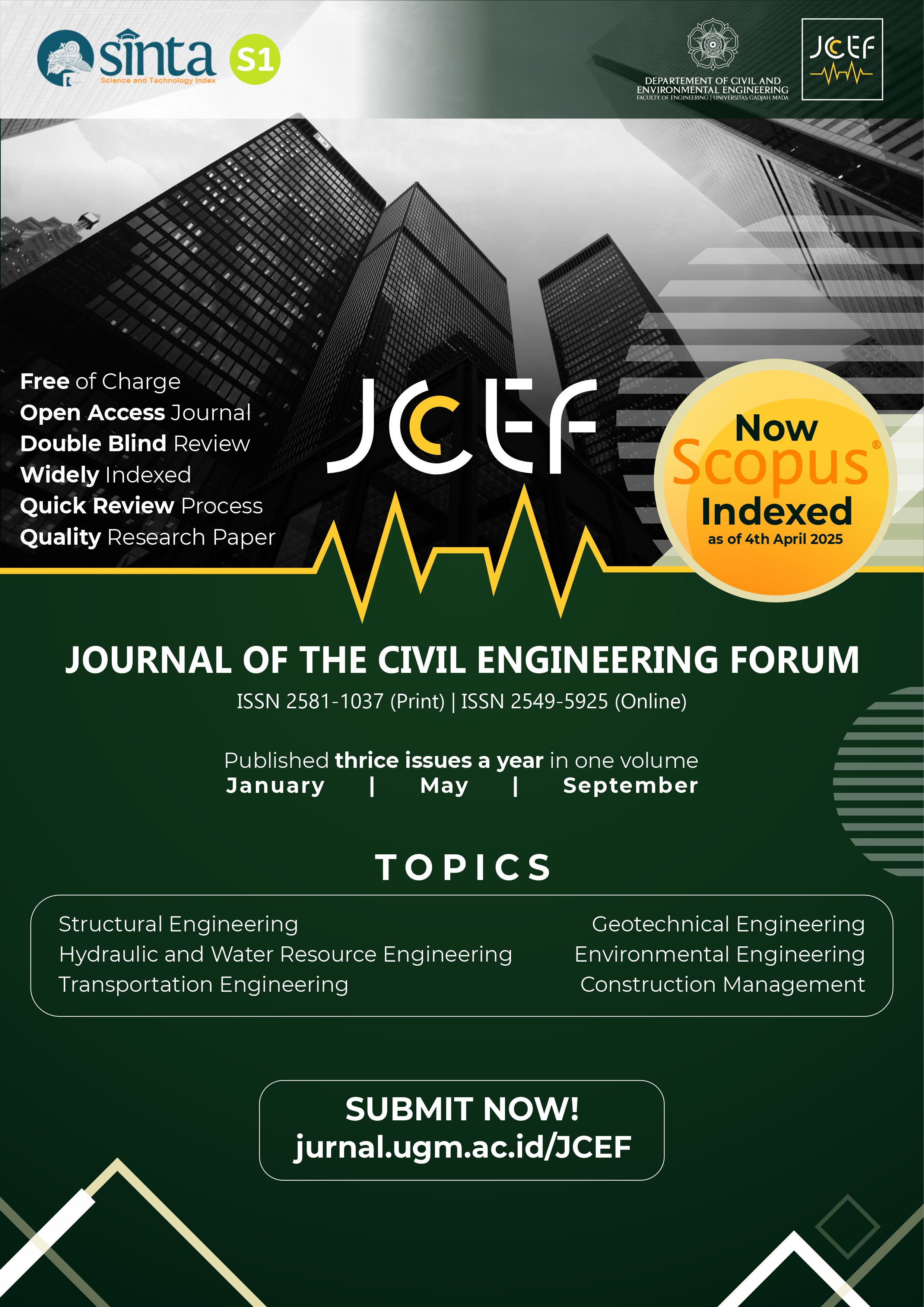Inconsistent using FLOOD and Flooding Development of EPA SWMM for Assessing Flood Occurrences in Vulnerable Urban Watershed Considering Extreme Rainfall Events
Abstract
Urban flood, commonly known as urban water congestion, is a type of water hazard that poses significant challenges for urban residents and water management experts. Chittagong, an essential economic hub in Bangladesh, renowned for its role as a port city, comprises a diverse range of land use, including residential, industrial, and commercial sectors. The Chaktai canal, an important element of Chittagong drainage system, is connected to the Karnaphuli river, playing a vital role in managing drainage by handling a substantial portion of the city water. Therefore, this research evaluated the operational efficiency of a specific drainage network under the influence of altered rainfall events using the Storm Water Management Model (SWMM). Using ArcGIS 10.4, the land use pattern of the area was researched, incorporating data from field surveys and secondary sources. SWMM 5.1 integrated watershed data, and further simulation was carried out to estimate runoff in various sub-catchments and drainage network limitations during heavy rain. During the intense monsoon period, the tool determined the average runoff depth, considering backwater effects and robust tidal surges, resulting in a depth of 3.3m compared to 2.6m in the dry season. This research evaluated the influence of impervious land use changes on urban drainage systems. While meteorological factors alone render drainage network sufficient in dry periods, the outfall shows vulnerability during the rainy season, with an allowance of only 0.7m, jeopardizing the catchment through flood. It contributed a schematic sub-catchment representation, emphasizing that flood events depend on volume runoff and peak flow in urban drainage system. SWMM model was used to illustrate the catchment surface runoff and interconnected node depths via conduits, as well as the current catchment scenario comprehensively.
References
Abbasizadeh, H., Nazif, S., Hosseini, S. A. and Tavakolifar, H. (2018), ‘Development of a coupled model for simulation of urban drainage process based on cellular automata approach’, Irrigation and Drainage 67(2), 269–281. URL: https://doi.org/10.1002/ird.2186
Ahmed, A. U. (2017), ‘Bangladesh climate change impacts and vu’, Climate Change Cell, Department of Environment.
Alam, S. (2022), Performance assesment of Chaktai Khal as urban drainage system under changed hygrologic and climate conditions, in ‘6th International Conference on Advances in Civil Engineering’, Chittagong University of Engineering & Technology, Chittagong.
Arnbjerg-Nielsen, K., Willems, P., Olsson, J., Beecham, S., Pathirana, A., Bülow Gregersen, I., Madsen, H. and Nguyen, V.-T.-V. (2013), ‘Impacts of climate change on rainfall extremes and urban drainage systems: A review’, Water Science and Technology 68(1), 16–28. URL: https://doi.org/10.2166/wst.2013.251
BMD (2017), ‘Bangladesh Meteorological Department’. [Accessed 4 September 2023]. URL: http://www.bmd.gov.bd/
Chowdhury, R. (2017), ‘Ctg canals on their deathbed, 12 have vanished’. [Accessed 4 September 2023].
Coles, S. (2001), An Introduction to Statistical Modeling of Extreme Values, Springer London, London. URL: https://doi.org/10.1007/978-1-4471-3675-0
Engel, B., Storm, D., White, M., Arnold, J. and Arabi, M. (2007), ‘A hydrologic/water quality model application’, JAWRA Journal of the American Water Resources Association 43(5), 1223–1236. URL: https://doi.org/10.1111/j.17521688.2007.00105.x
IPCC (2007), Climate Change 2007: The Physical Science Basis: Contribution of Working Group I to the Fourth Assessment Report of the Intergovernmental Panel on Climate Change, Cambridge University Press.
Islam, R. and Das, S. (2014), ‘Assessment of waterlogging and landslide vulnerability using cvat tool in Chittagong City corporation area multi hazard risk and vulnerability assessment, modeling and mapping (mrvam) view project pioneering numerical social-space prediction toward revolutionary changes in society view project’. URL: https://doi.org/10.13140/RG.2.2.14575.94885
Kim, H.-D., Kim, J.-T., Nam, W.-H., Kim, S.-J., Choi, J.-Y. and Koh, B.-S. (2016), ‘Irrigation canal network flow analysis by a hydraulic model’, Irrigation and Drainage 65, 57–65. URL: https://doi.org/10.1002/ird.1992
Kleidorfer, M., Mikovits, C., Jasper-Tönnies, A., Huttenlau, M., Einfalt, T. and Rauch, W. (2014), ‘Impact of a changing environment on drainage system performance’, Procedia Engineering 70, 943–950. URL: https://doi.org/10.1016/j.proeng.2014.02.105
Lu, W. and Qin, X. (2020), ‘Integrated framework for assessing climate change impact on extreme rainfall and the urban drainage system’, Hydrology Research 51(1), 77–89. URL: https://doi.org/10.2166/nh.2019.233
Luan, Q., Fu, X., Song, C., Wang, H., Liu, J. and Wang, Y. (2017), ‘Runoff effect evaluation of lid through swmm in typical mountainous, lowlying urban areas: A case study in China’, Water 9(6), 439. URL: https://doi.org/10.3390/w9060439
Mahmood, F. and Matin, M. (2018), ‘Assessment of drainage capacity of Chaktai and Rajakhali Khal in Chittagong City and inundation adjacent of urban areas’.
Mia, M., Nasrin, S., Zhang, M. and Rasiah, R. (2015), ‘Chittagong, Bangladesh’, Cities 48, 31–41. URL: https://doi.org/10.1016/j.cities.2015.05.011
Patowary, S., Hazarika, J., Sarma, A. and Asce, M. (2018), ‘Potential impact of climate change on rainfall extremes for urban drainage management’. URL: https://doi.org/10.1061/9780784482025.027
Rasel, M. M. and Chowdhury, M. T. U. (2015), ‘Modeling rainfall intensity duration frequency (r-idf) relationship for seven divisions of Bangladesh’.
Schwab, G. O., Frevert, R. K., Edminster, T. W. and Barnes, K. K. (1982), Soil and water conservation engineering, Vol. 134, LWW. URL: http://doi.org/10.4236/ojg.2016.68053
Tashmin, N., Muniruzzaman, M., Islam, S., Farzana, S. and Naher, S. (2018), ‘Challenges of local coping capacities due to climate change in the coastal regions of Bangladesh’, Journal of Geoscience and Environment Protection 06(08), 66–86. URL: https://doi.org/10.4236/gep.2018.68007
Terwisscha van Scheltinga (2015), Recent changes in temperature and rainfall trends and variability over Bangladesh, in ‘Recent changes in temperature and rainfall trends and variability over Bangladesh’, Gobeshona Conference on research on climate change in Bangladesh, Dhaka, pp. 24–24.
Thompson, D. (2018), ‘Assessment of flood causes and provision of control measures to prevent its effects’. URL: https://doi.org/10.3390/ijgi4031265
Wang, K.-H. and Altunkaynak, A. (2012), ‘Comparative case study of rainfall-runoff modeling between swmm and fuzzy logic approach’, Journal of Hydrologic Engineering 17(2), 283–291. URL: https://doi.org/10.1061/(ASCE)HE.19435584.0000419
Wernstedt, K. and Carlet, F. (2014), ‘Climate change, urban development, and storm water: Perspectives from the field’, Journal of Water Resources Planning and Management 140(4), 543–552. URL: https://doi.org/10.1061/(ASCE)WR.19435452.0000308
Willems et al. (2012a), ‘Climate change impact assessment on urban rainfall extremes and urban drainage: Methods and shortcomings’, Atmospheric Research 103, 106–118. URL: https://doi.org/10.1016/j.atmosres.2011.04.003
Willems et al. (2012b), Impacts of Climate Change on Rainfall Extremes and Urban Drainage Systems, IWA Publishing.
Willems, P., Olsson, J., Arnbjerg-Nielsen, K., Beecham, S., Pathirana, A., Bülow Gregersen, I., Madsen, H. and Nguyen, V. (2012), Limitations and pitfalls of climate change impact analysis on uurban rainfall extremes.
Xiong, L., Yan, L., Du, T., Yan, P., Li, L. and Xu, W. (2019), ‘Impacts of climate change on urban extreme rainfall and drainage infrastructure performance: A case study in Wuhan City, China’, Irrigation and Drainage 68(2), 152–164. URL: https://doi.org/10.1002/ird.2316
Yan, L. (2014), ‘Analysis of storm runoff simulation in typical urban region of Wuhan based on swmm’, Journal of Water Resources Research 03(03), 216–228. URL: https://doi.org/10.12677/JWRR.2014.33028
Zhang, H., Yang, Z., Cai, Y., Qiu, J. and Huang, B. (2021), ‘Impacts of climate change on urban drainage systems by future short-duration design rainstorms’, Water (Switzerland) 13(19). URL: https://doi.org/10.3390/w13192718
Copyright (c) 2024 The Author(s)

This work is licensed under a Creative Commons Attribution-ShareAlike 4.0 International License.
Copyright is granted to authors for the purpose of providing protection for articles written to describe experiments and their results. JCEF will protect and defend the work and reputation of the author and are also willing to address any allegations of violation, plagiarism, fraud, etc. against articles written and published by JCEF. JCEF is published under the terms of the Creative Commons Attribution-ShareAlike 4.0 International License (CC BY-SA 4.0). The author holds the copyright and assigns the journal rights to the first publication (online and print) of the work simultaneously.





